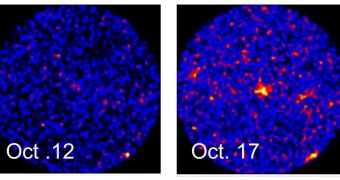Just recently, two research groups identified a new source of bright X-ray emissions in our galaxy, the Milky Way. The radiation comes from a binary system that was until now hidden in the constellation Centaurus.
A binary system is basically a pair of stars, in which either one of the bodies rotates around a more massive one, or two equal-size fireballs spin around a common center of gravity.
In these type of structures, peculiar interactions develop between the two components, which can lead to events such as X-ray novae. These are instances in which one of the stars, usually the largest one, detonates.
This is precisely what investigators in the United States and Japan found earlier this month. They caught a binary star system as it was entering a X-ray nova state.
Most likely, what happened was that the largest star released a massive blast wave of X-rays into its surroundings. This often happens as a result of accretion.
In binary systems, the larger star tends to consume, or accrete, matter from the other one, gulping it up until it grows in size and mass beyond a certain threshold.
Once that happens, the excess mass is released as radiation in powerful cosmic explosions known as novae. Unlike supernovas, the core of the detonating star does not collapse to form a neutron star or a black hole.
Using the Monitor of All-Sky X-ray Image (MAXI) instrument on the International Space Station (ISS) Kibo Module's Exposed Facility, the Japanese team identified the X-ray novae on October 20.
Nine hours after the alert was sent to the international astronomical community, scientists from the Pennsylvania State University (Penn State) trained the NASA Swift X-ray Telescope towards the blast.
“The collaboration between the MAXI and Swift teams allowed us to quickly and accurately identify this new object,” explains Penn State Swift instrument scientist Jamie Kennea.
“MAXI and Swift’s abilities are uniquely complementary, and in this case have provided a discovery that would not have been possible without combining the knowledge obtained from both,” he adds.
Although this type of cosmic explosions usually occur in regular binary star systems, the new observations seem to imply that the new case may be a bit special.
““The Swift observation suggests that this source is probably a neutron star or a black hole with a massive companion star located at a distance of a few tens of thousands of light years from Earth in the Milky Way,” adds David Burrows.
“The contribution of Swift’s X-ray Telescope to this discovery is that it can swing into position rapidly to focus on a particular point in the sky and it can image the sky with high sensitivity and high spatial resolution,” he says.
The new object was dubbed MAXI J1409-619, says Burrows, who is a professor of astronomy and astrophysics at Penn State, and also the Swift lead scientist, Space Fellowship reports.

 14 DAY TRIAL //
14 DAY TRIAL //